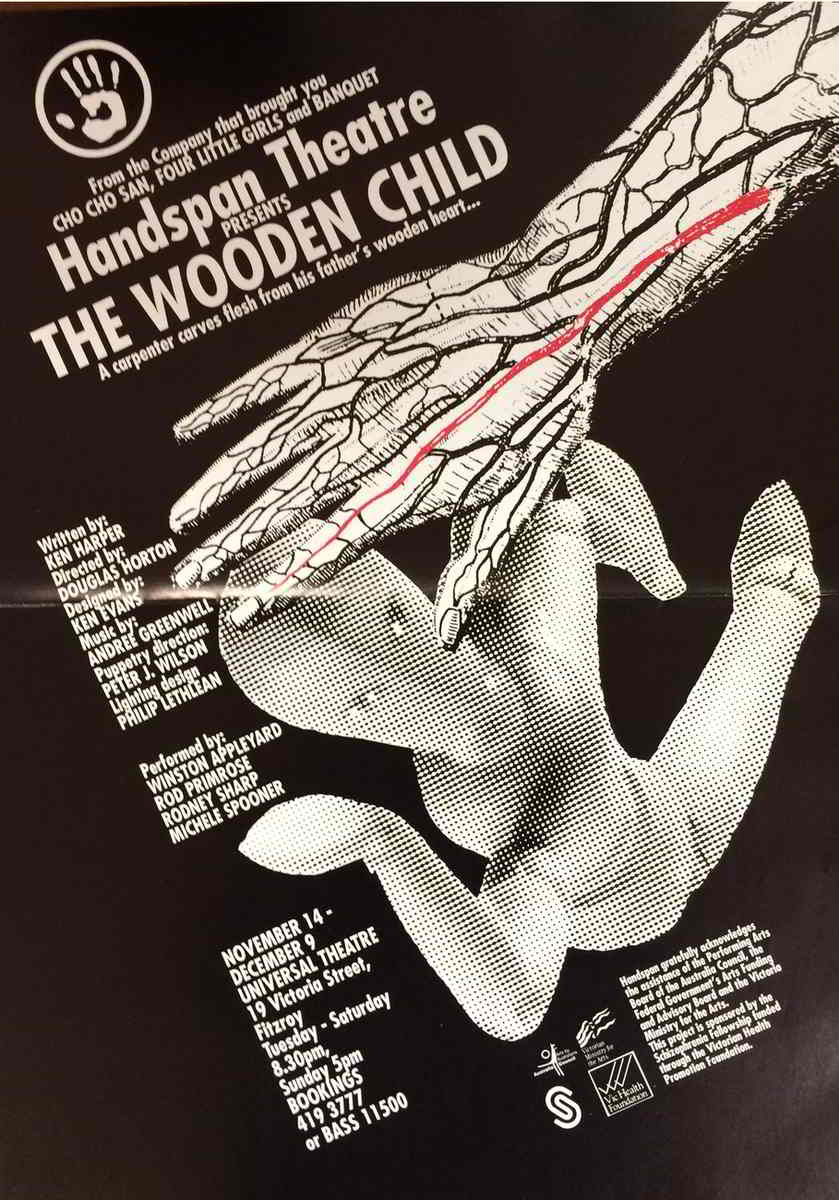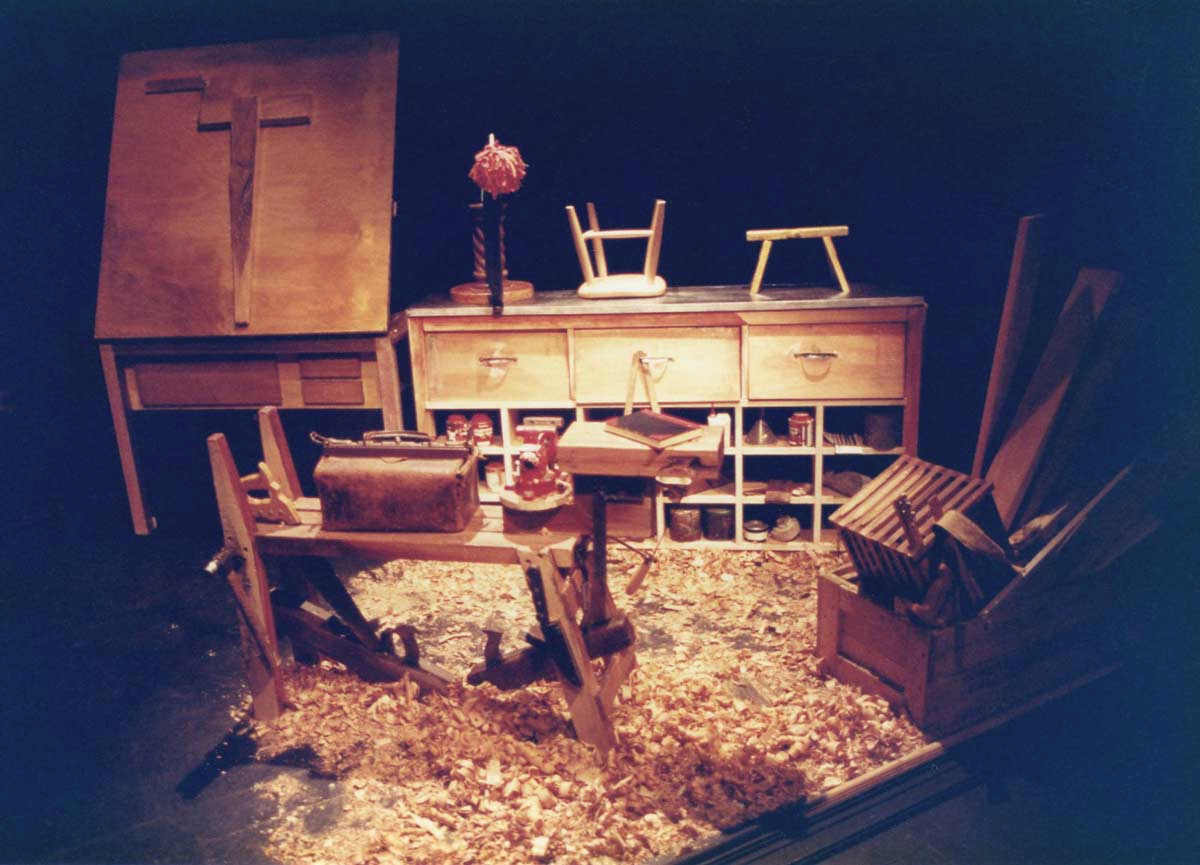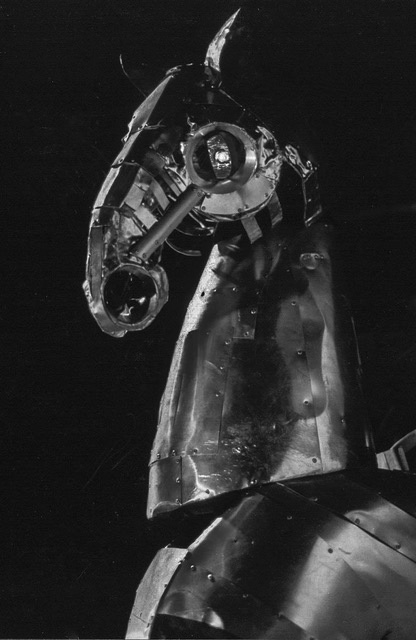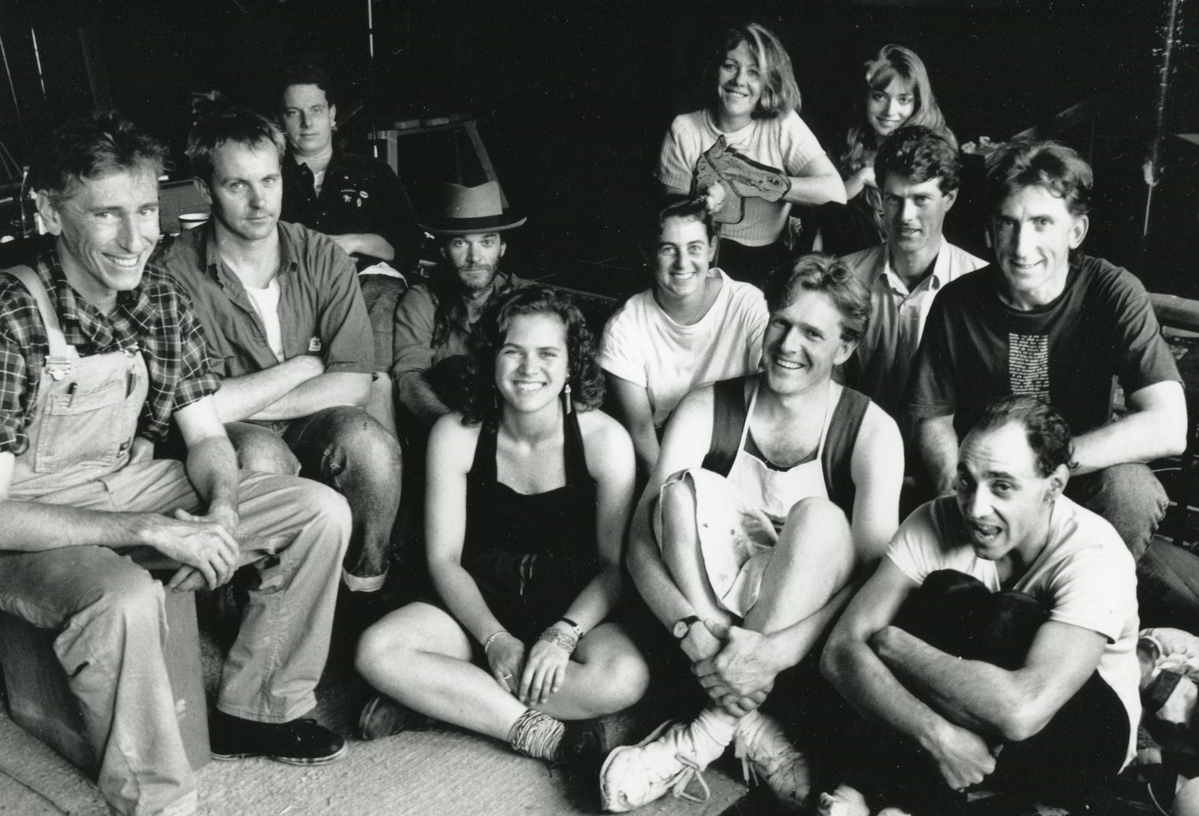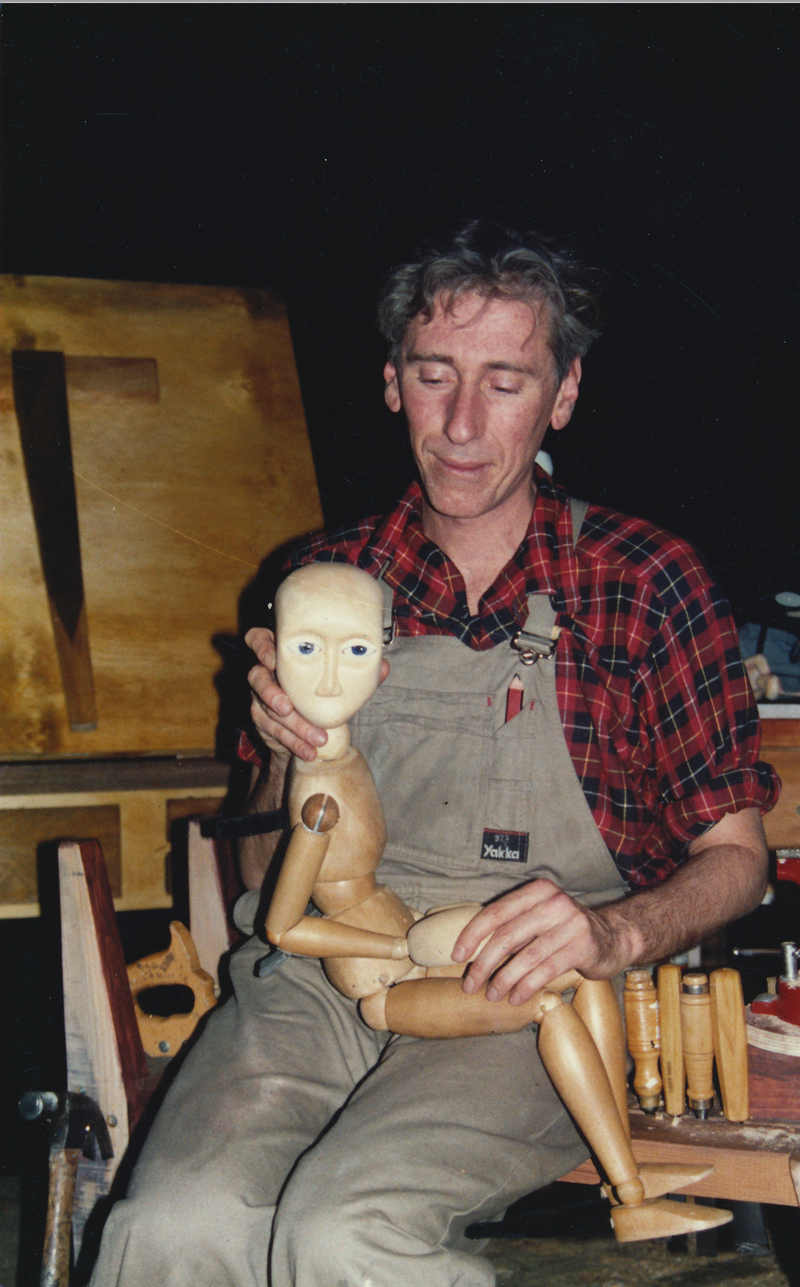| Premiere | 9 November, 1990, Castlemaine State Festival |
| Venue | Castlemaine Library Hall |
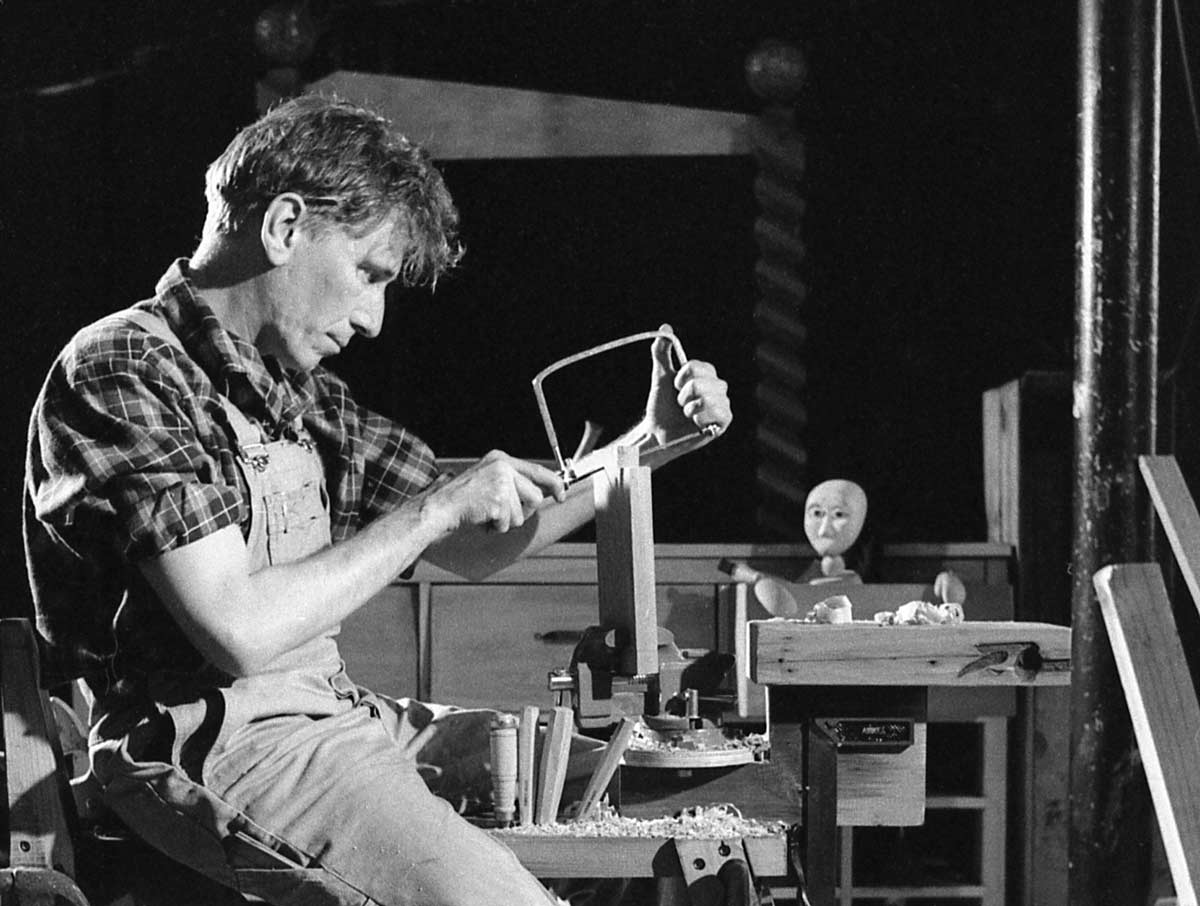
THE WOODEN CHILD explored the subject of boys’ relationships with their fathers and men’s emotional responses to childbirth. It was subject matter close to the lives of Handspan artists several of whom were themselves beginning to have children and experience the complicated reality and conflicting emotions of parenthood at the time this work was produced.
The work was first conceived in discussions during production of Running Up A Dress by Suzanne Spunner. produced by Home Cooking Company in 1986. Carmelina Di Guglielmo and Meredith Rogers performed the play about housewifely roles and realities, and on the sidelines, their husbands, Ken Evans and Ken Harper became inspired to plan a new work about 'men's business'. Putting in a Diff, conceptually in it first plan, to be staged around Ken Evans' 1960s red holden ute.
In the following years, the play evolved, written by Ken Harper during his wife's pregnancy and based on workshops with male colleagues at Handspan, Ken Evans, Rod Primrose and Peter J.Wilson, with woodcraftsman, Barry Mills.
The Wooden Child arose from my curiosity about the myth and images in our culture that portray men and children... What is it that we do and think as a culture that turns our male children into men and what is the cost and benefit to us all
There is an implicit sadness in the play about aspects of being male. There is a certain sense of solitude handed down from father to son - a fear of intimacy. And a sadness about the things children learn from their fathers - obsessions with the outer world for example, war and business. The play looks at the constructive rather than the destructive side of the quality.
The Play
THE WOODEN CHILD was staged in black theatre on a full stage, and set in a carpenter’s workshop.
Its plot wove three father-son narratives together. Carlo Collodi's story of Pinocchio paralleled a story of an adult making toys for his unborn child while reflecting on his own childhood relationship with his father. The carved wooden puppet became the young boy watching his father go off to business and to war - always distant. The carpenter's nurturing love
The carpenter, played by Rod Primrose carved wooden characters and toys with a nuturing love that illustrated his potential to be both a creator and a destroyer as they became animated by him and around him.
Critical accolades
Predominantly critics were impressed:
The play is masculine but delicately so: it holds up the male psyche for recognition rather than aggressive celebration. It is absorbing and richly rewarding and requires concentration and intelligence from its audience. A challenging, warm and satisfying piece.
Its theme is the making of a male child into a man. The images of the play are mostly those of growth, development and caring: a small child measuring himself against the awesome and imposing figure of his father, a child's hobby horse which sprouts wings and Pegasus-like acquires the power of flight, and two wonderful prancing horses, one of which breathes smoke and fire and turns into a spitfire piloted by the one-time airman grandfather. The storyline is not always clear but at its best this is a gentle and affecting piece of visual theatre.
The stories are told with a minimum of language, focusing on the complex and suggestive symbolic images Handspan has made its own, which reach beyond narrative into an instant and deep psych recognition. This show has a quality of enthralling gentleness, an innocence which makes it an unusually moving experience. I remember in particular two scenes: one in which the puppet-child watches his father go to war and build a mock-father out of the bloodied shrapnel pieces he brings back as the only tokens of love he can give him; the other is when the carpenter puts together the beautiful toy he has made for his baby.
With a sense of enormous delicacy and a sincerity marked by doubt and pain, The Wooden Child suggests an alternative beyond the absent father so embedded in our culture as a mark of maleness: the possibility of a father giving his children an articulate love instead of inarticulate pain.
This is a dense and intriguing work: sometimes too dense. is Harper vision father as nurturer? Or is it father as sole nurturer? Does he even intend to imply the second question? Perhaps not, but he does. Ind the end The Wooden Child is disturbing, highly provocative, perhaps too obscure - but always visually astonishing.
The production moved some audience members to send notes of affirmation about their emotional response to the work. Two are reproduced in this document: Fan Letters to The Wooden Child (pdf)
One Melbourne writer only, didn't agree:
The characters, whether human or puppet were merely representative of character and emotionally sterile. While many of the images in the play were initially stunning, repetition rendered them ineffectual. After the initial emotional response, the images became static and retained only their symbolic meaning which became tired.
Project sponsorship
THE WOODEN CHILD production team included workshop assistant Kevin Berton, supported by the Schizophrenia Fellowship of Victoria's Work Rehabiliation Program. and a video of his successful experience working in Handspan's Gertrude St Studio to build the work was produced to support Vichealth's campaign message for 1990 - Schizophrenia - a treatable illness:
| Creative team | |
|---|---|
| Writer | Ken Harper |
| Director | Douglas Horton |
| Designer | Ken Evans |
| Music | Andree Greenwell |
| Lighting designer | Philip Lethlean |
| Puppetry direction | Peter J.Wilson |
| Performers | |
|---|---|
| The Carpenter | Rod Primrose |
| The Father | Rodney Sharp |
| Puppeteer | Winston Appleyard |
| Puppeteer | Michele Spooner |
| Voiceovers | Cliff Ellen, Richard Fitzgerald, Nigel Frayne, Ken Harper, Ian Pidd, Rod Primrose, Rodney Sharp, Julie Forsyth |
| Production team | |
|---|---|
| Puppet & prop makers | Rob Matson with Paul Newcombe, Philip Millar, Mary Sutherland, Horse |
| Set construction | Barry Mills |
| Scenic painting | Horse |
| Costumes | Wiggy Brennan |
| Workshop assistant | Kevin Berton |
| Production & Stage Manager | Jo Sapir |
| Sound operator | Andree Greenwell |
| Sound engineer | Nigel Frayne |
| Graphics | John Dickson |
| Photographer | Ponch Hawkes |
| Seasons | |
|---|---|
| 9 - 11 November 1990 | Castlemaine Library Hall, Castlemaine State Festival, Victoria |
| 14 Nov – 9 December 1990 | Universal Theatre, Fitzroy, Victoria |
| 4 Jan -19 January 1991 | The Playhouse, Sydney Opera House, Festival of Sydney, NSW |
| Total performances | 25 (1990 est); 19 (1991) |
| Total audience | 2950 (1990 est); 1,100 (1991) |
